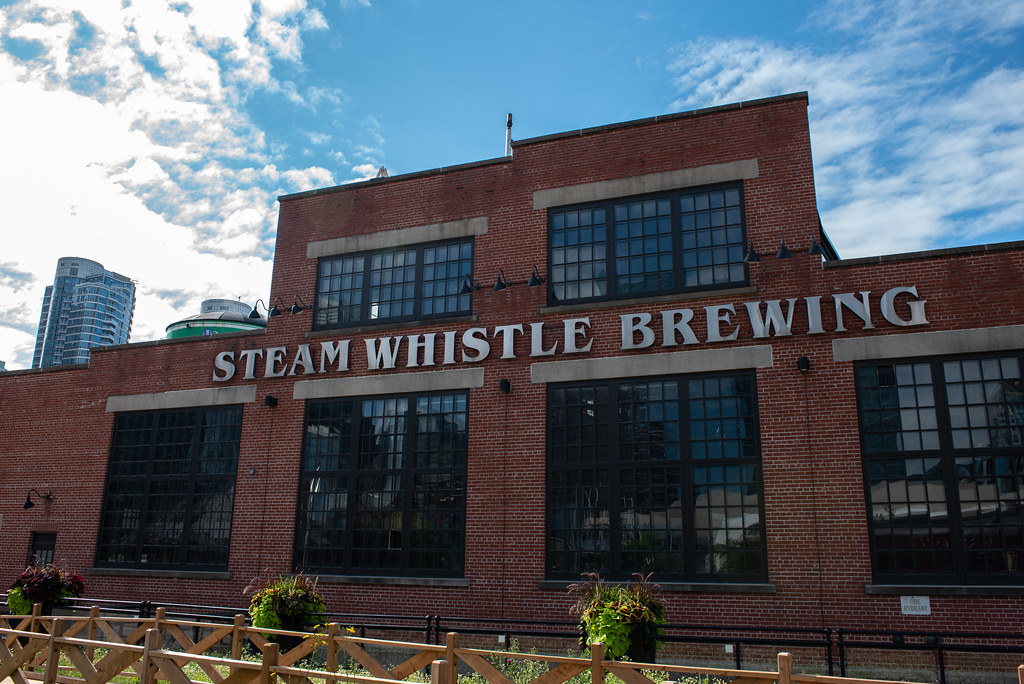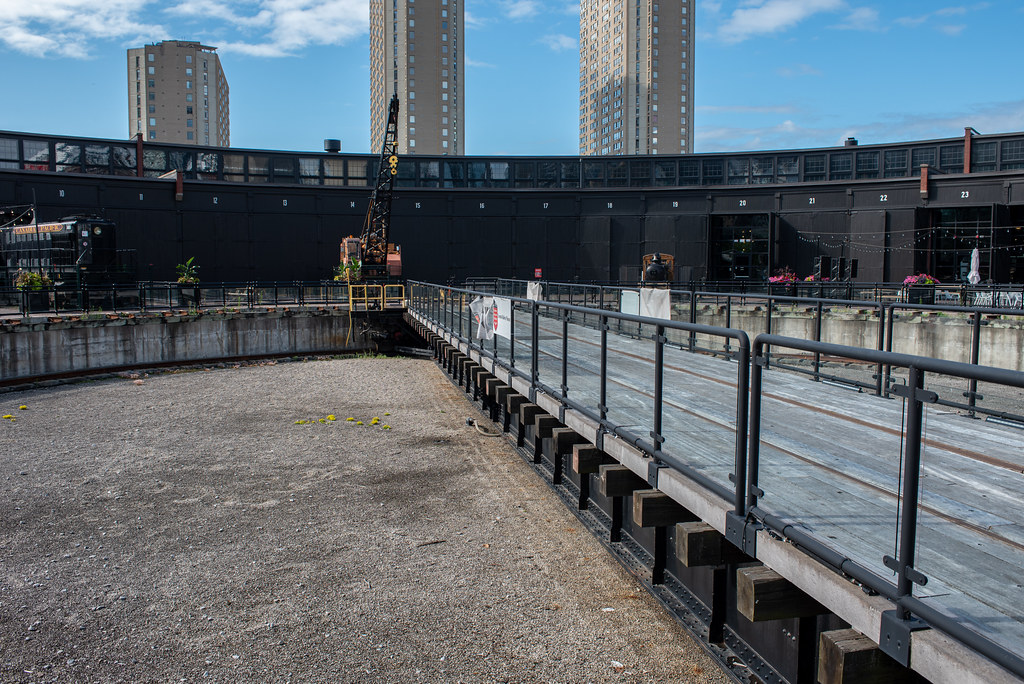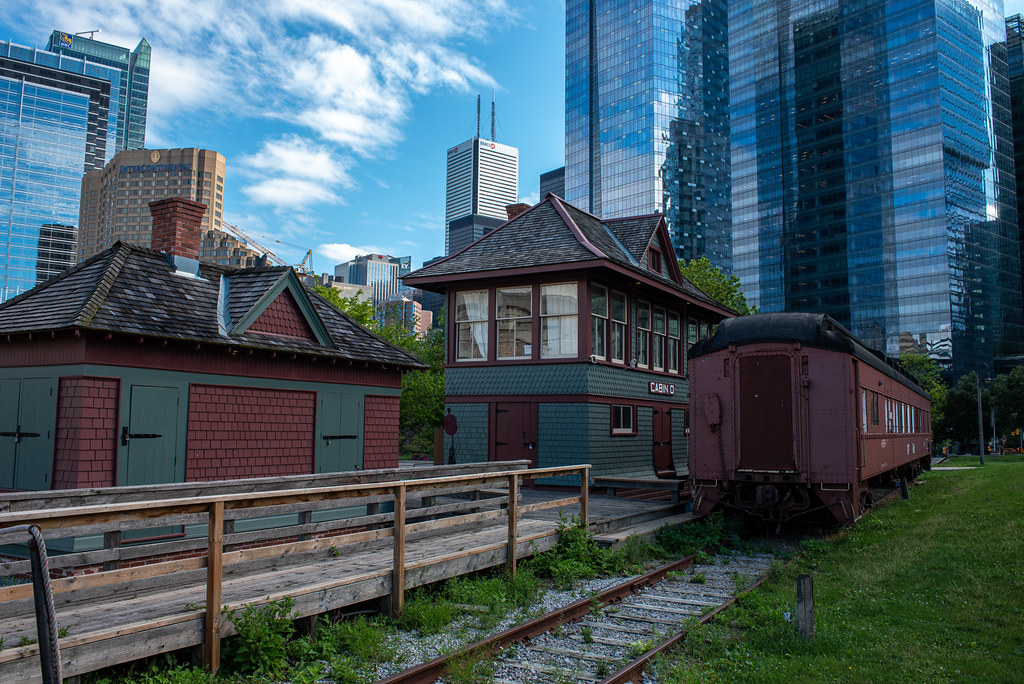Last week I alluded to the rail lands in Toronto; these lands dominated the space between the lake and Union Station on Front Street. These lands grew up through the late 1850s as the anchor point to major and minor operators. Space was used to marshall, maintain, and store rolling stock fleets. And one of the most prominent buildings in these yards was the roundhouse.

Graflex Crown Graphic – Fuji Fujinon-W 1:5.6/125 – Ilford HP5+ @ ASA-200 – Pyrocat-HD (1+1+100) 9:00 @ 20C
The idea of the roundhouse as a means to store and maintain locomotives is credited to Robert Stephenson. He designed the structure and used one with the London & Manchester Railway. While that roundhouse is long gone, the world’s oldest roundhouse can be found in Derby, England, dating back to 1837. Grand Trunk established the first roundhouse on the rail lands in 1857 and added a second in 1875. The story of the John Street roundhouse started in 1879 when the Credit Valley Railway opened its West Toronto maintenance yard. The yard included a small roundhouse turntable. Additionally, maintenance was carried out in a car shop, paint shop with a machine shop and blacksmith for part fabrication. The entire Credit Valley line ended up under Canadian Pacific Control in 1884. Canadian Pacific used the yards as their main base of operations for the City and quickly replaced the original turntable with a new steel unit to better support the heavier locomotives. The turntable was the key to the roundhouse design; locomotives would be moved onto the table, turned into the position of the bay they were entering and slid home, similarly allowing for easy exit from the bays. And finally allowed for turning the entire engine around without needing to operate in reverse was difficult for steam locomotives. The problem with positioning their maintenance facilities in West Toronto was that most passenger services remained centred at Union Station and the rail lands. When their branch line along the Don River opened in 1896, Canadian Pacific began expanding the old Credit Valley freight yards in the rail lands. It was taking with them the turntable from the West Toronto facility. When the John Street facilities opened, the roundhouse had a total of twenty-one bays and a twenty-one-metre turntable; new car shops, machine shops, and other support buildings provided everything needed to maintain the fleet of passenger trains running to and from Union Station. Canadian Pacific expanded the roundhouse with eleven additional bays in 1900. The turntable saw replacement in 1911 with a twenty-four-metre table and again in 1918 with a twenty-six-metre table.

Nikon D750 – AF-S Nikkor 28-70mm 1:2.8D
Nikon D750 – AF-S Nikkor 28-70mm 1:2.8D
It became clear after the war that as locomotives only grew in size, the old roundhouse and turntable could not be expanded any further. Canadian National had replaced the ex-Grand Trunk 1875 Roundhouse (the 1857 roundhouse went down in 1890) in 1927 to further modernise and standardise their locomotive fleet. Canadian Pacific contracted the work out to Anglin & Norcross in 1929 to design and build a new larger roundhouse. As work progressed, the old roundhouse went down in sections to make room for the new building. The new facility opened in 1931, boasting thirty-two stalls and a thirty-seven-metre turntable. The new roundhouse could easily store and maintain any locomotive in the Canadian Pacific Fleet. A new powerhouse supplied electricity and heat to the entire complex. The roundhouse stood at 9,300 square metres of floor space and had at least 150 workers on site nearly twenty-four hours a day, seven days a week. Locomotives and other rolling stock that passed through the John Street yards were noted for getting a John Street polish to the high quality demanded of the staff. And the yard’s reputation was well earned when it ran a complete service on Locomotive 2337, a Pacific Type 4-6-2, which powered a special train taking US President Franklin D. Roosevelt on a fishing trip in Northern Ontario in 1943. The roundhouse and yards also saw the earliest arrivals of diesel-electric locomotives, first in the form of switchers and then post-war the movement towards road-type and road-switcher locomotives. Despite being designed around steam motive power, the size of the John Street roundhouse allowed it to continue to work even in the diesel era. But these massive facilities designed around maintaining steam locomotives that needed far more regular maintenance than the average diesel-electric locomotives were a product of a bygone age. Also becoming redundant along with the roundhouse were the massive rail yards. Most operators were moving major yard work outside the City; Canadian National saw fit to start construction in 1973 of a new communications tower, the CN Tower. As passenger service ended, John Street served the earliest locomotives in the VIA Rail Fleet until even those were moved west of the City. In 1986, Canadian National knocked down the Spadina Roundhouse to make room for a new sports stadium. We know the stadium as the Skydome or the Rodgers Centre today. The John Street roundhouse closed that same year as the railyards shrunk to almost nothing, and the first condo towers were starting to show on the Toronto skyline.

Nikon D750 – AF-S Nikkor 28-70mm 1:2.8D
Nikon D750 – AF-S Nikkor 28-70mm 1:2.8D
The City quickly recognised John Street as the last roundhouse in Toronto and slapped a heritage designation on the building before Canadian Pacific could knock it down in 1990. Canadian Pacific donated the roundhouse to the City for development into a museum and park. Work on the project started in 1995 with a major renovation; as the Metro Toronto Convention Centre aimed to expand southward, a third of the roundhouse was dismantled and rebuilt on the other side of the building. During this project, the foundations of the 1897 roundhouse came to light and were documented and buried again. The IBI group conducted the work on restoration and renovation of the roundhouse with additional support from the furniture giant Leon’s. First to open was roundhouse park in 1997, and a few pieces of rolling stock were displayed in the park. In 2000 Steam Whistle Brewing opened a craft brewery in a section of the roundhouse, followed closely by a Leon’s Furniture store. In 2001 the Toronto Railway Heritage Association began converting a quarter of the roundhouse into a museum; the work lasted nine years before their grand opening during a Doors Open event in May 2010. Today, the museum occupies two bays of the roundhouse, has an extensive collection of rolling stock and a functioning switcher, and has even gotten the massive turntable up and running. But they also feature a rideable mini-train and have preserved several buildings, including a GTR traffic control tower and the old Don Station. Even if you don’t visit the museum, a trip to roundhouse park is well worth your time.